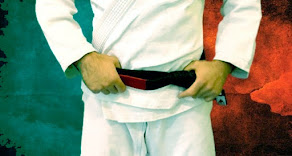 |
| OLD SCHOOL |
Pochi aspetti del Jiu-Jitsu hanno visto una così grande evoluzione come i ribaltamenti, una manovra in cui i praticanti partono da una posizione di inferiorità per terminare in una di superiorità.
La spazzata a forbice è forse il ribaltamento più basico e funziona anche ad alti livelli nel Grappling e nelle arti marziali miste ma solo se viene eseguito al momento giusto e con le giuste transizioni.
La spazzata a forbice è una delle prime tecniche ad essere insegnata perché aiuta i nuovi allievi a capire il posizionamento del corpo, la mobilità dell'anca, le prese, la gestione della distanza, l'equilibrio e la distribuzione del peso.
Il motivo per cui poi molti scartano questa tecnica è perché la maggior parte delle versioni classiche richiedono di sbilanciare l'avversario da una posizione frontale, ma la cosa è estremamente difficile se questi ha una buona postura e una buona base. Se l'avversario mette peso indietro e si siede sui suoi talloni è molto difficile riuscire a spazzarlo è per questo che si consiglia di usare questa tecnica quando l'avversario ha messo un piede a terra.
La versione "vecchia scuola" della spazzata a forbice, era fatta con le gambe quasi completamente dritte e senza caricare il peso dell'avversario sullo stinco, come si può vedere nella foto di apertura.
La spazzata a forbice si presenta in diverse variazioni, oggi vi mostro le tre principali:
# Prima variazione: la posizione è sul fianco e si sforbicia con le gambe parallele. Occorre sbilanciare l'avversario in avanti stando attenti a non caricarlo troppo sulla tibia, in nessun caso il tallone deve toccare il sedere.
# Seconda variazione: Ci si mette in appoggio sull' avambraccio, il ginocchio non scende al livello della cintura ma rimane puntato sullo sterno e la gamba che sforbicia segue una traiettoria diagonale. Come nella precedente versione occorre far alzare l'avversario sui talloni. In entrambe le versioni occorre restare ben laterali.
# Terza variazione: come nella seconda variazione il ginocchio rimane puntato sullo sterno. Ci si estende molto e il tallone destro (in questo caso) rimane piantato all'interno della coscia. La meccanica della spazzata ricorda il push kick sweep ma il piede che spinge non è il sinistro ma il destro. L'altra gamba sfalcia come nelle altre varianti.
Tutte queste versioni, tuttavia, non sono così facili da realizzare se si è in linea retta con il proprio avversario. Angolandosi, invece, la spazzata diventa senza sforzo. L'idea è quella di ribaltare un cubo su uno dei suoi angoli ma per questo argomento vi rimando ad un prossimo post.
La
spazzata a forbice si è vista raramente nelle MMA perché il
ribaltamento si basa su una presa al collo e una rottura della postura
che è raro riuscire ad ottenere sia nel NO-GI che nelle MMA. In
UFC 139 invece Matt Brown l'ha usata con successo contro Seth Baczynski.
Few aspects of Jiu-Jitsu have gone through such great evolution as the sweep, a maneuver where the practitioner starts out on bottom and ends up on top. The scissor sweep is maybe the most basic sweep and work even in high level grappling and mixed martial arts.
The scissor sweep is taught early because help new students to understand body positioning and hip mobility, grips, distance management, balance and weight distribution
The reason why alot of people discard this move is because most of the classic versions require you to unbalance your opponent which is extremely difficult if he has good posture and base and yoiu stay just in front of him. If your opponent base back and sit heavy on his heals it will make very difficult to sweep him that is why usually it is recommended to use this technique when the opponent has put a foot on the ground.
The old school version of the scissor sweep, was done with almost completely straight legs and without loading the opponent weight onto his own shin as you can see in the opening pic. In the modern days there are different variations out there,today I show you the top three:
# First variation: position your body sideways, the sweeping legs must remain parallel. The opponent must be unbalanced forward and pay attention to not load his weight too much on the shin. Your heel should never touch the bottom.
# Second variation: Stay on your forearm, the knee does not drop to the belt level but remains pointed on the sternum. The sweeping legs follow a diagonal path. As in the previous version is necessary to raise the opponent on their heels. In both versions you must be sideways.
# Third variation: as in the second version, the knee remains pointed on the sternum. Stretch you out and at the same time kick with both legs to gain the proper distance. The right heel (in this case) remains planted inside of the thigh. the mechanics of the sweep recalls the push kick sweep but in this case the pushing foot is the right. The other leg sweeps as in the other variations.
All of these versions, however, are not so easy to realize if you are in a straight line with your partner. Angleing in the right way the sweep becomes effortless. The idea is tipping a cube over one of the corners applies, but for this topic I refer you to the next post.
The scissor's sweep it is rarely seen in MMA because the sweep relies on a collar grip and posture breakdown that is rare to achieve simultaneously in the no-gi environment of MMA. In UFC 139 however Matt Brown used it succesfully against Seth Baczynski




















.jpg)
0 comments:
Posta un commento